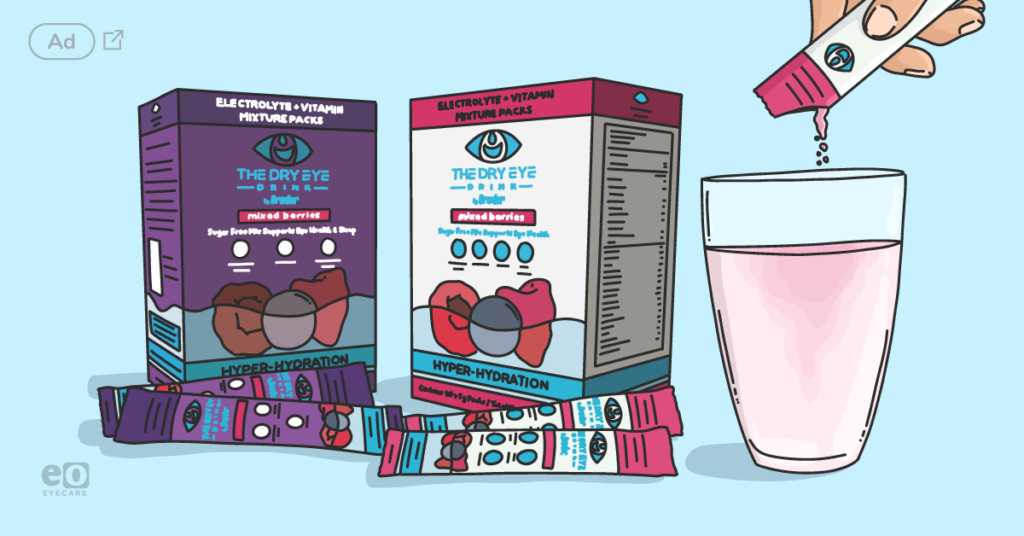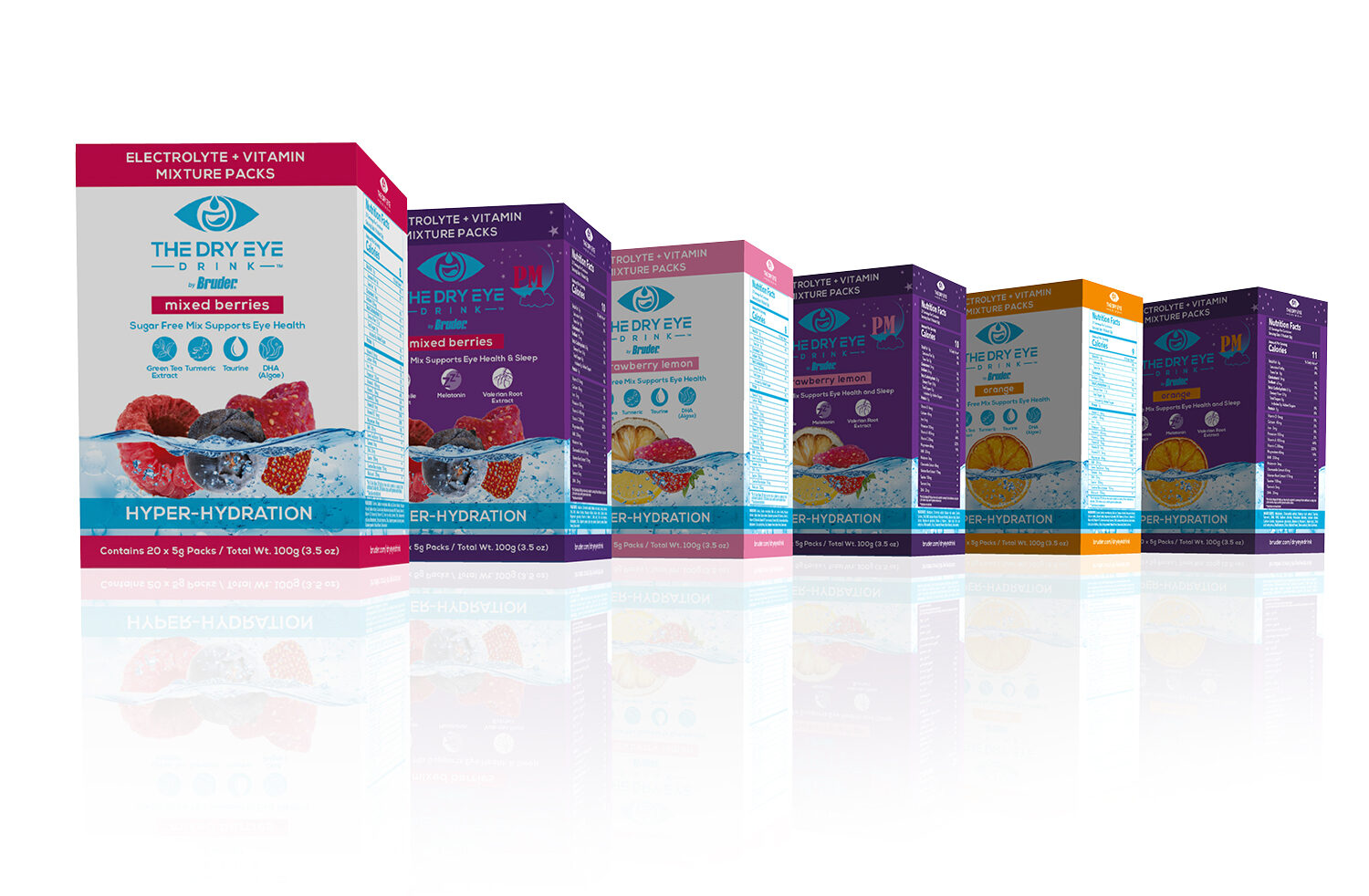When the body is not properly hydrated, it can lead to a decrease in tear production and an increase in tear evaporation, which can result in dry, itchy, and uncomfortable eyes. But try telling this to patients! While you may get knowing stares or nods of affirmation, a doctor’s suggestion to “drink more water” is rarely enough to inspire patients to drink as much as they should. That’s because drinking lots of water can feel like a chore that some patients either don’t enjoy or can’t fit into a busy routine. However, as a robust body of research shows, this spells trouble for millions of patients with ocular surface disease. Fortunately, a team of eye care providers and scientists have developed a practical solution to help make hydration easier, faster and more effective.
Hydration Research
One of the first published studies on the effects of whole-body hydration (i) was published more than a decade ago and, since that time, the body of research on this topic has grown considerably. This initial research by Walsh and colleagues found that patients with dry eye have higher plasma osmolality (Posm) relative to individuals who do not have dry eye. (ii) Notably, Posm is widely recognized as a whole-body hydration marker. (iii)
Prior to this, earlier research demonstrated that dehydration evoked by exercise in non-dry eye patients led to a progressive increase in tear film osmolarity (Tosm). (iv) Furthermore, when fluid boluses were provided to improve whole-body hydration, Tosm increased. (v) This finding is significant in light of the fact that elevated Tosm is related to ocular inflammation in dry eye (vi) and therefore has led to theorizing about what effects whole-body hydration might have on patients who are already suffering with dry eye disease. (vii,viii)
In the human eye, the highest concentration of water is found in the aqueous and vitreous humor, but high water content is evident elsewhere, including in the corneal stroma, which is about 80% water (ix) and is extremely dependent on hydration status (x) particularly with regard to central corneal thickness. (xi)
Challenges with Water Consumption
 We now know that dehydration can cause a decrease in tear production, changes in the composition of the tears, and dysfunction of the meibomian glands. Conversely, ensuring that patients stay hydrated can help prevent dry eye and alleviate its symptoms. Unfortunately, patients are not consuming the recommended intake of daily fluids per the National Academy of Medicine: 13 cups for healthy men and 9 cups for healthy women (1 cup equaling 8 ounces). While expert recommendations from a variety of sources are publicized, adult men are only consuming an average 5.5 cups a day. Adult women are consuming only 5.375 cups a day. The statistics get worse for adults over 60 years of age, where the average drops to 4.5 cups daily.
We now know that dehydration can cause a decrease in tear production, changes in the composition of the tears, and dysfunction of the meibomian glands. Conversely, ensuring that patients stay hydrated can help prevent dry eye and alleviate its symptoms. Unfortunately, patients are not consuming the recommended intake of daily fluids per the National Academy of Medicine: 13 cups for healthy men and 9 cups for healthy women (1 cup equaling 8 ounces). While expert recommendations from a variety of sources are publicized, adult men are only consuming an average 5.5 cups a day. Adult women are consuming only 5.375 cups a day. The statistics get worse for adults over 60 years of age, where the average drops to 4.5 cups daily.
Another challenge: hydration goes beyond simply drinking water since electrolyte balance plays a crucial role in maintaining hydration levels. In short, patients need expert help in meeting their hydration demands, particularly as they relate to ocular surface health. While some have turned to sport drinks and other high electrolyte beverages, doctors caution that, despite helping patients quickly overcome dehydration, many of these options are unsuitable for regular use due to high sugar and sodium content. Also, none are specifically formulated with ingredients shown to benefit ocular structures in particular.
Treat dry eye from the inside out. Get The Dry Eye Drink™ by Bruder® for your practice. As an Eyes On Eyecare subscriber, you’ll enjoy a 10% discount off the doctors-only pricing for our popular flavor mix bundle.
Hydration Designed Specifically for Eye Health
The need for a healthy drink alternative led a group of optometrists and ophthalmologists to develop a new eye-healthy formula. After countless hours of work and 43 formulations, The Dry Eye Drink was born. When combined with water this powdered mix can provide two to three times the hydration of water alone. That’s because electrolytes deliver hydration to the blood stream and cells faster than water alone. Importantly, The Dry Eye Drink includes additional healthy ingredients that have been shown as beneficial to the eyes, without adding inflammatory ingredients like sugar. For example, the daytime formula of Dry Eye Drink contains green tea extract, turmeric, taurine, omega-3s and vitamins A, C and B3, B6 and B12. This specifically formulated powdered drink substance is meant to be drank two times per day to help hyper-hydrate patients.
The drink includes only natural ingredients, is vegan, lactose-free, gluten-free, sugar-free (sweetened with stevia extract) and contains no genetically modified organisms (GMO). To date, the team has created three flavors: mixed berries, orange and strawberry-lemon. And since lack of sleep can also affect the eyes, a nighttime version was created, replacing the B Vitamins and Green Tea extract with Melatonin, Chamomile extract, and Valerian root extract.
Help Patients Help Themselves
Dry eye costs the US healthcare system billions per year (xii) to say nothing of lost productivity in the workforce or quality of life. While there are many ways to address dry eye, one of the simplest ways—hydration—is too often overlooked, despite widely-accepted evidence that points to its importance. Boosting hydration is a cornerstone in treating countless conditions. It’s basic common sense that it should likewise take the lead in dry eye management. Using the time-tested science of electrolytes, The Dry Eye Drink can deliver hydration to the bloodstream and cells faster and more efficiently than water alone.
While the uphill climb to encourage more water consumption continues, The Dry Eye Drink by Bruder helps patients help themselves by making the most of the liquids they consume.







